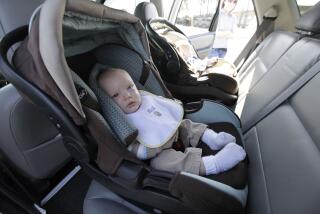Wagon Jump Seats: Safe for Kids?
- Share via
Station wagons are almost synonymous with kids, who seem to love the cars’ cavernous passenger compartments and especially the rear-facing jump seats that many wagons feature.
After infants graduate from baby seats, which are the safest possible protection, it’s easy to assume they are ready for those jump seats, located just inches from the rear bumper.
But are jump seats a safe place to ride?
You wouldn’t catch Barry Felrice in one. Felrice is associate administrator for rule making at the National Highway Transportation Safety Administration, the federal agency that sets vehicle safety standards.
“There isn’t much space between the occupant’s toes and the rear bumper,” Felrice said. “It isn’t any place that I would want to be.”
Indeed, the jump seats are inside the so-called crumple zone that occurs during a major collision. Accident data, however, do not clearly demonstrate that these seats are unsafe, Felrice said.
Between 1988 and 1990, 11 occupants of rear-facing seats died nationwide. (There were 32,695 deaths in all passenger-car accidents and about 44,000 deaths in all types of accidents.)
The 11 fatalities occurred in seven crashes (in some cases, more than one person died). In three of those seven crashes, the station wagon was rear-ended by a heavy truck.
So clearly, a major rear-end collision when kids are riding in jumps seats is a risk. But how great a risk?
Rather than indicating the seats are safe, the few deaths might show that adults drive more safely with kids, Felrice noted. Of course, station wagons also are tiny fraction of all cars, and the third seats are seldom used.
So, overall death data is not particularly relevant to answering the question of whether the seats are safe when occupied.
The Center for Auto Safety, a consumer group, believes that jump seats are unsafe.
“If you are hit by a large truck, you could be squashed like a pancake,” said Russell Shew, a vehicle safety researcher at the center. “The probability of injury is very high. These are the least safe seats in a car.”
The center is planning to petition the government to improve all standards for seats, requiring stronger latch mechanisms and stiffer seat backs. But Felrice, aside from his personal feelings, said the data do not show a clear safety problem that requires additional federal regulations.
Under current rules, jump seats must conform to the same requirements as the other auto seats. One exemption is that jump seats can be equipped with only lap belts, whereas other outboard seats must have three-point shoulder and lap belt systems.
An analysis done by the highway safety administration for The Times shows that the probability of injury to occupants in the front seats of stations wagons is 47% in all types of major accidents. The probability is 38% in rear seats and 8% in jump seats.
On this basis, the jumps seats are the safest place; that’s because most serious accidents are frontal crashes rather than rear end crashes.
The Insurance Institute for Highway Safety, a trade group, estimates that 94% of fatal crashes are frontal accidents. In a frontal crash, a rear-facing seat can be quite safe, because the force of crash on the body is distributed against the entire seat back. The exception would be if the occupant’s head extends over the seat back, in which case there is no protection from a serious neck injury.
The overall picture left by the data and expert opinion is not clear. Not a lot of people are killed in these jump seats, but they seem inherently less safe. Who wants to ride inside a crumple zone?
If you do intend to put your kids in a jump seat, you need to drive more carefully. And Felrice advises that kids should not use the jump seat if their heads extend over the top of the seat.





